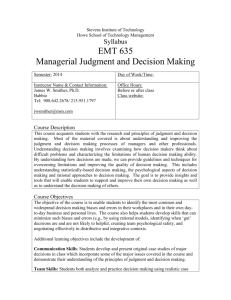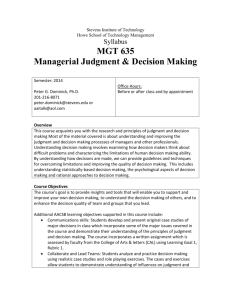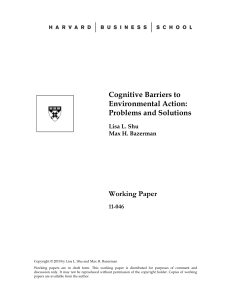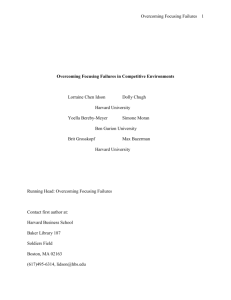Ethical Conduct - Stevens Institute of Technology
advertisement
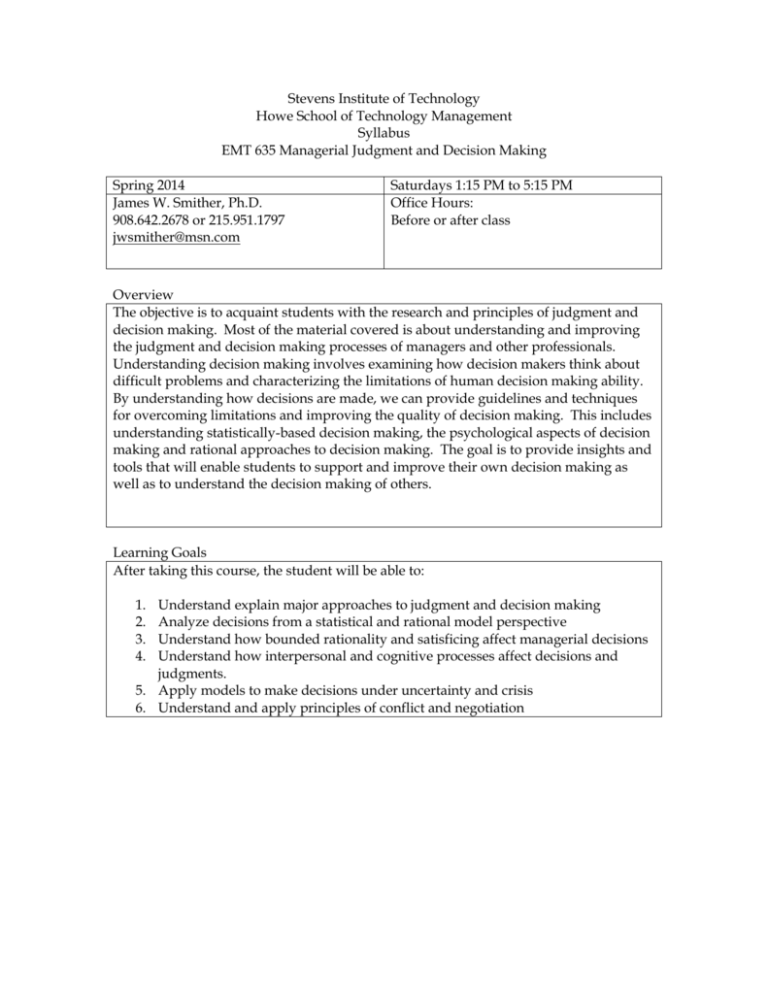
Stevens Institute of Technology Howe School of Technology Management Syllabus EMT 635 Managerial Judgment and Decision Making Spring 2014 James W. Smither, Ph.D. 908.642.2678 or 215.951.1797 jwsmither@msn.com Saturdays 1:15 PM to 5:15 PM Office Hours: Before or after class Overview The objective is to acquaint students with the research and principles of judgment and decision making. Most of the material covered is about understanding and improving the judgment and decision making processes of managers and other professionals. Understanding decision making involves examining how decision makers think about difficult problems and characterizing the limitations of human decision making ability. By understanding how decisions are made, we can provide guidelines and techniques for overcoming limitations and improving the quality of decision making. This includes understanding statistically-based decision making, the psychological aspects of decision making and rational approaches to decision making. The goal is to provide insights and tools that will enable students to support and improve their own decision making as well as to understand the decision making of others. Learning Goals After taking this course, the student will be able to: 1. 2. 3. 4. Understand explain major approaches to judgment and decision making Analyze decisions from a statistical and rational model perspective Understand how bounded rationality and satisficing affect managerial decisions Understand how interpersonal and cognitive processes affect decisions and judgments. 5. Apply models to make decisions under uncertainty and crisis 6. Understand and apply principles of conflict and negotiation Pedagogy The course will employ lectures, class discussions, and in-class exercises. A series of exercises are used to illustrate principles of judgment and decision making. Exercises include the taxi problem (an illustration of Bayesian reasoning), a group decisionmaking exercise, the prisoner’s dilemma, a two-person negotiation exercise, and a variety of case examples. Students must complete two papers. The first requires analyzing the decision-making failures (as well as other factors) that led to the airline disaster at Tenerife and the 1996 Mt. Everest disaster. The second requires analyzing the decision-making processes during the Cuban missile crisis. The final project requires developing an original case study of a decision, including the context, background, decision, and aftermath. Students must use decision-making concepts from the course to describe and analyze the case. Each student will make a formal presentation of the case and will answer questions from the class and professor. 2 Required Text Text: Bazerman, M.H., & Moore, D.A. (2009). Judgment in Managerial Decision Making, 7th ed., Wiley. Readings 1. Belkin, L. (2002). The odds of that. The New York Times Magazine, August 11. 2. * Bikhchandani, S., Hirshleifer, D., & Welch, I. (1998). Learning from the behavior of others: Conformity, fads, and informational cascades. The Journal of Economic Perspectives, 12, 151-170. 3. Bruck, C. (2009). Angelo’s ashes. The New Yorker, June 29. 4. Dana, J., & Dawes, R.M. (2004). The superiority of simple alternatives to regression for social science predictions. Journal of Educational and Behavioral Statistics, 29, 317-331. 5. * Eden, D., & Shani, A. B. (1982). Pygmalion goes to boot camp: Expectancy, leadership, and trainee performance. Journal of Applied Psychology, 67(2), 194-199. 6. * Folger, R., & Konovsky, M.A. (1989). Effects of procedural and distributive justice on reactions to pay raise decisions. Academy of Management Journal, 32, 115-130. 7. * Frederick, S. (2005). Cognitive reflection and decision making. Journal of Economic Perspectives, 19, 25-42. 8. * Galotti, K. M. (2007). Decision structuring in important real-life choices. Psychological Science, 18, 320-325. 9. Gawande, A. (2007). The checklist. The New Yorker. 10. * Gilovich, T., Vallone, R., & Tversky, A. (1985). The hot hand in basketball: On the misperception of random sequences. Cognitive Psychology, 17, 295-314. 11. Gladwell, M. (2009, July 27). Cocksure: Dept. of finance. The New Yorker, 85(22), 24. 12. * Gladwell, M. (2008). The ethnic theory of plane crashes. In M. Gladwell (author), Outliers: The story of success (pp. 177-223). New York: Little, Brown, and Company. 13. Gladwell, M. (2004). Personality plus. The New Yorker, September 20. 14. Gladwell, M. (2002). Blowing Up. The New Yorker. April 22 and 29, 162-173. 3 15. Groopman, J. (2007). What’s the trouble? The New Yorker, January 29. 16. Hardman, D. & Harries, C. (2002). How rational are we? The Psychologist, 15(2), 76-79. 17. Hyashi, A.M, (2001, February). When to trust your gut. Harvard Business Review, 59-65. 18. * Kruger, J., Savitsky, K., & Gilovich, T. (1999). Superstition and the regression effect. Skeptical Inquirer, 23, 24-29. 19. Lehrer, J. (2008, July 28). The eureka hunt. The New Yorker, 40-45. 20. * Lovallo, D., Viguerie, P., Uhlaner, R., & Horn, J. (2007, December). Deals without delusions. Harvard Business Review, 92-99. 21. * Milkman, K.L., Chugh, D., & Bazerman, M.H. (2009). How can decision making be improved? Perspectives on Psychological Science, 4, 379-383. 22. * Milkman, K.L., Rogers, T., & Bazerman, M.H. (2008) Harnessing our inner angels and demons: What we have learned about want/should conflicts and how that knowledge can help us reduce short-sighted decision making. Perspectives on Psychological Science, 3, 324-338. 23. Mishlove, J. To err is human. In ‘The Roots of Consciousness.’ http://www.williamjames.com/Science/ERR.htm. 24. * Myers, D.G. (2002, November/December). The powers and perils of intuition. Psychology Today, 42-52. 25. * Probst, G., Raisch, S. (2005). Organizational crisis: The logic of failure. Academy of Management Executive, 19, 90-105. 26. Reilly, R.R. (2010). Introduction to probability for decision making. 27. Roberto, M.A., & Carioggia, G.M. (2003). Mount Everest – 1996. Harvard Business School. 28. * Shih, M., Pittinsky, T. L., & Ambady, N. (1999). Stereotype susceptibility: Identity salience and shifts in quantitative performance. Psychological Science, 10, 80-83. 29. * Staw, B.M., & Hoang, H. (1995). Sunk costs in the NBA: Why draft order affects playing time and survival in professional basketball. Administrative Science Quarterly, 40, 474-494. 4 30. * Smithson, M. (2009). Psychology’s ambivalent view of uncertainty. In G. Bammer & M. Smithson (Eds.), Uncertainty and risk: Multidisciplinary perspectives (pp. 205-217). Earthscan Publications. 31. Surowiecki, J. (2007, November 19) Striking out. The New Yorker. 32. * Willis, J., & Todorov, A. (2006). First impressions: Making up your mind after a 100-ms exposure to a face. Psychological Science, 17, 592-598. 33. Begley, S. (2010, August 5). The limits of reason: Why evolution may favor irrationality. Newsweek, http://www.newsweek.com/search.html?q=The+limits+of+reason 5 Assignments The course will emphasize class discussion focused around the exercises and the analysis of the text and other assigned readings. Students are expected to be prepared to discuss the assigned readings as well as concepts and examples in the text. Two papers (each analyzing decision making cases) are assigned plus an original final case study. Class Participation To enhance the learning experience for everyone, all students are expected to participate in class discussions and team exercises. Attendance is an important component of this grade. In addition, each student will prepare and deliver a brief presentation on one of the assigned readings. The assignments and their weights are as shown below: Assignment Grade Percent Case Study I 25% Case Study II 25% Final Presentation 35% Article Presentation and Class Participation 15% Total Grade 100% 6 Ethical Conduct The following statement applies to all students taking Stevens courses, on and off campus. Cheating during in-class tests or take-home examinations or homework is, of course, illegal and immoral. A Graduate Academic Evaluation Board exists to investigate academic improprieties, conduct hearings, and determine any necessary actions. The term ‘academic impropriety’ is meant to include, but is not limited to, cheating on homework, during in-class or take home examinations and plagiarism. Consequences of academic impropriety are severe, ranging from receiving an ‘F’ in a course, to a warning from the Dean of the Graduate School, which becomes a part of the permanent student record, to expulsion. Reference: The Graduate Student Handbook, Academic Year 2003-2004 Stevens Institute of Technology, page 10. Consistent with the above statements, all homework exercises, tests and exams that are designated as individual assignments MUST contain the following signed statement before they can be accepted for grading. _______________________________________________________________________ I pledge on my honor that I have not given or received any unauthorized assistance on this assignment/examination. I further pledge that I have not copied any material from a book, article, the Internet or any other source except where I have expressly cited the source. Signature _______________________________________ Date: _____________ Please note that assignments in this class may be submitted to www.turnitin.com, a web-based anti-plagiarism system, for an evaluation of their originality. 7 Topic Course overview Randomness and statistical models Common biases Course Schedule Readings and other activities Power Point slides Readings: 1, 4, 10, 14, 26 Prisoner’s dilemma game Questions for common biases and framing in decision making Power Point slides Bazerman & Moore Chapters 1 and 2 Readings: 7, 8, 9, 15, 16, 18, 20, 23, 30 Framing and the Power Point slides reversal of Bazerman & Moore Chapter 4 preferences Readings: 22, 29 Tenerife video Non-rational escalation of commitment Group decision Power Point slides making Readings: 12, 25, Mt. Everest case (27) Leaderless group discussion Winter survival exercise Motivational Power Point slides and emotional Bazerman & Moore Chapter 5 influences on Readings: 2, 3, 5, 11, 13, 28, 32 decision making Tenerife and Mt. Everest paper due Class exercise (handout) Implicit association test (IAT) https://implicit.harvard.edu/implicit/ Fairness and Power Point slides ethics in Bazerman & Moore Chapter 7 decision making Readings: 6, 17, 19, 24, 31 Cuban missile crisis video Intuition Negotiations Power Point slides Bazerman & Moore Chapters 9 and 10 Papa Pagone’s negotiation Arak-Barkan negotiation Student case presentations Improving Power Point slides decision making Bazerman & Moore Chapter 11 Readings: 21, 33 Student case presentations Paper on Cuban missile crisis due Session Session 1 (1/18) Session 2 (2/1) Session 3 (2/8) Session 4 (2/22) Session 5 (3/8) Session 6 (3/22) Session 7 (4/5) Session 8 (4/26) (4/30) 8 Presentations on Assigned Readings Each week one or more readings will be assigned to one or two students. Prepare a 10to 15-minute presentation on each reading. Do not try to present all the details about the article; only present sufficient information that we will all understand the key findings/points. Summarize the article What are the essential points made by the author? Discuss the implications of the article for decision making 9 Cuban missile crisis Write a report analyzing the decisions made in the Cuban Missile crisis. Your report should utilize the concepts covered by Bazerman and the assigned readings to answer the following questions. The report should be no longer than 5 double-spaced pages. 1. What were the major issues to be decided? 2. What were the major sources of uncertainty? 3. What were the key decisions made during the crisis? 4. How did framing affect the decision makers and the decision process? 5. To what extent did the decision makers generate alternatives? 6. Describe the decision-making process used by President Kennedy? 7. What were the key sources of influence on the ultimate decision? 8. In retrospect, could a better set of decisions have been made from the U.S. perspective? 10 Tenerife and Mt. Everest After viewing the Tenerife video and reading the Mt. Everest – 1996 case, prepare a report that describes … The individual-level decision making biases that contributed to the disasters The team-level factors (or processes) that contributed to the disasters The systems-level factors that contributed to the disasters Be sure to emphasize the similarities in individual-level, team-level, and systems-level factors that contributed to both disasters. The report should be no longer than 5 double-spaced pages. 11 EMT 635 Spring 2014 Name: Prefer to be called? Your e-mail address? Your work or home phone number (optional): Your undergraduate major? If you have another graduate degree, what was your major? Years of full-time work experience? Brief description of current job? Have you or do you now supervise others? If yes, indicate number of years of supervisory experience and number of people you supervised. Career goal after graduation? 12
